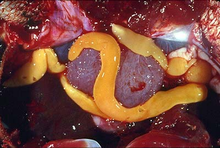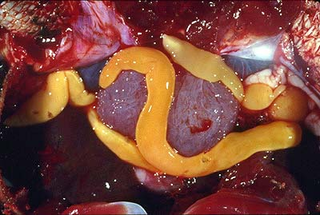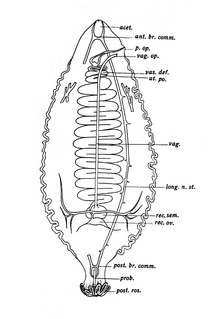| Cestodaria | |
|---|---|
 | |
| Adults of Gigantolina elongata in body cavity of freshwater turtle. | |
| Scientific classification | |
| Kingdom: | Animalia |
| Phylum: | Platyhelminthes |
| Class: | Cestoda |
| Subclass: | Cestodaria |
Cestodaria is one of two subclasses of the class Cestoda. The Cestodaria subclass is made up of Amphilinidea and Gyrocotylidea. The larvae have ten hooks on the posterior end. [1]

Cestoda is a class of parasitic worms in the flatworm phylum (Platyhelminthes). Most of the species - and the best-known - are those in the subclass Eucestoda; they are ribbonlike worms as adults, known as tapeworms. Their bodies consist of many similar units, known as proglottids, which are essentially packages of eggs which are regularly shed into the environment to infect other organisms. Species of the other subclass, Cestodaria, are mainly fish parasites.

Amphilinidea (amphilinid) is the name given to an order of parasitic flatworms of the phylum Platyhelminthes. Amphilinids are Cestodes, yet differ from true tapeworms (Eucestoda) as their bodies are unsegmented and not divided into proglottids. "Amphilinids are large worms which have a flattened leaf-like body. Only 8 amphilinid species are known." "The adults are hermaphroditic. A muscular proboscis is located at the anterior end, and is sometimes very weakly developed or absent." They live in the body cavities of freshwater turtles and teleost fish as adults, and in the bodies of various crustaceans as juveniles. Apart from a little studied parasitism of sturgeon, these flatworms have very little economic importance. Biologically, they have gained attention for their potential to shed light on the phylogeny of tapeworms.

Gyrocotylidea is an order of Cestoda (tapeworms). Members of this order are parasites of vertebrates, living in the coelom.

![<i>The Fauna of British India, Including Ceylon and Burma</i> London,Taylor & Francis; [etc.]1888- | Multiple institutions View Book](https://upload.wikimedia.org/wikipedia/commons/thumb/b/b7/WTBlanford.jpg/240px-WTBlanford.jpg)
